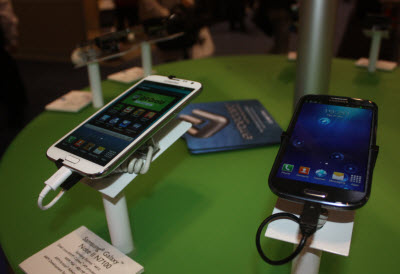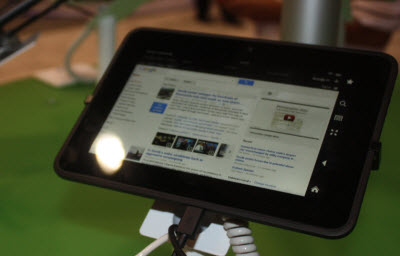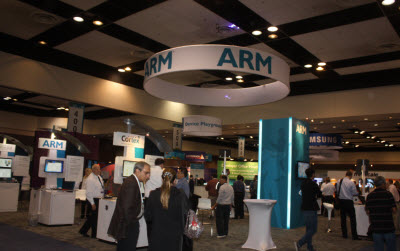In the microprocessor wars, ARM and its many partner allies have always had the most units sold in the market. But Intel, which can sell chips for $100 or more, has always had the lion’s share of the profits in a $30 billion-plus industry. With the growing popularity of smartphones and tablets, ARM is a rising star while Intel’s core PC market is weakening. And this week, Intel rival Advanced Micro Devices announced it would move beyond Intel-compatible chips to making ones based on ARM designs.
The secret is low power, as ARM’s chip architecture was designed from the beginning decades ago to handle low-power operations while Intel focused on performance. But now that servers run so hot, serving Internet pages by the billions, heat and electricity usage has become a major problem in data centers. Allied with AMD, ARM has a shot at taking on Intel in server chips. Warren East, the chief executive of Cambridge, England-based ARM, said his teams began working on server chips more than five years ago, and now the project is bearing fruit. AMD plans to launch its first 64-bit ARM-based server chips in 2014. That gives Intel time to cut its power usage and attack the smartphone and tablet markets with low-power chips of its own.
The battle is a gargantuan one, pitting the vertically integrated Intel against the horizontal, virtual ecosystem of ARM. Intel designs its own chips and builds them in its own multibillion-dollar factories, assembles them in huge plants, and then sells them to PC makers and retailers. ARM creates the basic design building blocks, such as an architecture and microprocessor cores. Its licensees — such as AMD, Broadcom, AMCC, and a host of others — take those designs and create working chips around the components. They then produce the chips or get contract manufacturers such as Taiwan Semiconductor Manufacturing Co. to do so. Which business model will win? East, of course, believes that the virtual way is best. He has scores of companies on his side, and each takes a share of the profit. Compared to them, Intel doesn’t look so intimidating after all. We caught up this week with East at the ARM TechCon show in Santa Clara, Calif., where attendance was up. Here is an edited transcript.
VentureBeat: Intel versus ARM is always an interesting discussion. Which style of business is going to win here? Vertical versus virtual?
 Warren East: Strangely enough, my thinking hasn’t really changed much. [Laughs] Clearly, the vertical business model has been fantastic for Intel, from the x86 period of the late ’80s up through now. It’s been good for Intel, and it’s been good for Microsoft. But it hasn’t been good for everybody involved. A lot of the PC manufacturers are on low margins, and the original device manufacturers [ODMs] are on even thinner margins than that. The world is ready for a change.
Warren East: Strangely enough, my thinking hasn’t really changed much. [Laughs] Clearly, the vertical business model has been fantastic for Intel, from the x86 period of the late ’80s up through now. It’s been good for Intel, and it’s been good for Microsoft. But it hasn’t been good for everybody involved. A lot of the PC manufacturers are on low margins, and the original device manufacturers [ODMs] are on even thinner margins than that. The world is ready for a change.
We have a different business model. It’s much more distributed and collegiate and so on. But that means everybody has a more equitable share of the profit. Companies like that. Embedded in the ARM philosophy, and my philosophy too, is the belief that the collaborative approach is more sustainable long-term.
It’s human nature. As a society we make bigger strides when we collaborate than when we try to sit in our own silos and do our own thing. You can get a short-term win that way. I talked in the keynote about the “internet of things,” and how the technology is essentially in place. There are silos where people are doing their own thing.
VentureBeat: Apple’s a good example of the opposite, or vertical integration, where they do everything on their own.
East: In the world of the internet of things, that demonstrates that technology has a place there. But technology can have a much bigger place if there’s collaboration. It’s not easy. It takes some time for these things to happen. But absolutely think that the distributed approach is the one that wins. Can I ask you, what do you think?
VentureBeat: I think by lots of different measures, you can judge how that is going. If you think of units, then you guys are winning (ARM licensees sell billions of chips a year). When it comes to profits, Intel is winning. Maybe profits distributed more evenly is where you guys would be ahead.
East: Yeah. I’m not sure that we’re not winning in total profits as well, if you look through the value chain. If you look just at the chip level and look at Intel’s microprocessor revenue and ARM’s microprocessor revenue, it’s roughly the same, but Intel’s margins are much higher than the typical ARM semiconductor partner. But added to the typical ARM semiconductor partner’s margins, the ARM margin, though it’s relatively small in absolute terms. You also have to look further down the value chain at ARM customers. You find that there’s more margin available for their customers than there is in the Intel world.
 That’s a more stable, healthy situation. More margin means there can be more innovation going on. Intel invests huge amounts of profits back in R&D — and don’t get me wrong, I think they do a wonderful job at what they do — but it means that people in the value chain downstream from Intel don’t have as much profit available to reinvest, and so you don’t get such levels of innovation as you do in the ARM world. In terms of how you make a good impact on society, it’s better if there are more people innovating.
That’s a more stable, healthy situation. More margin means there can be more innovation going on. Intel invests huge amounts of profits back in R&D — and don’t get me wrong, I think they do a wonderful job at what they do — but it means that people in the value chain downstream from Intel don’t have as much profit available to reinvest, and so you don’t get such levels of innovation as you do in the ARM world. In terms of how you make a good impact on society, it’s better if there are more people innovating.
VentureBeat: They’ve tried to race ahead on manufacturing technology, with this idea of having a two-year lead. Whether or not that’s true, that’s tough competition. And this is something that is not in your control. You can’t govern how much money gets invested in the manufacturing of ARM chips.
East: There are advantages to the vertical model. You have more control. That produces a win, but it’s a short-term, less sustainable win. Hopefully you saw the panel we ran this morning, and that was there to demonstrate that as far as the manufacturing world is concerned, the ARM manufacturing partners are not that far behind Intel.
In the nature of their business models, they service lots of independent companies. When you compare that with what Intel does — the manufacturing arm effectively services just one company — then Intel will always be able to bring up a new semiconductor process and ship products ahead of the foundries. The task they have is much simpler. The foundries have to service more customers and have a broader range of intellectual property up and running on their processes. Historically they have to run many different flavors of their process. They’re narrowing that down.
But that says the vertical model gives Intel a small lead. It doesn’t give them the massive, sustainable lead that they talk about in their marketing. If I look at what’s actually going on today, then for system-on-chip designs going into things like phones, Intel products are 32 nanometers, and the products that people like Samsung and Qualcomm are supplying are 28 nanometers. That sounds like the same to me, not Intel having a lead.
 VentureBeat: Apple is in your camp, it looks like. They’re investing by pre-buying capacity, and that helps the foundries invest.
VentureBeat: Apple is in your camp, it looks like. They’re investing by pre-buying capacity, and that helps the foundries invest.
East: Absolutely. You heard Shang-yi [Chiang] this morning talking about TSMC’s forward-looking investment plans. They’re going to invest another chunk. I think everybody is investing. They need to do that. Theoretically, yeah, Intel can invest more than an individual foundry company can. But that investment doesn’t necessarily lead to a sustainable lead in the market. With a lot of technology developments, there’s a zone where if you put more money into the project, you get a result faster or you get a better result. After a certain point, though, you reach the law of diminishing returns. You put more money in and you don’t get anything better out.
VentureBeat: You and Intel are invading each other’s territory.
East: Makes a good story. [laughs]
VentureBeat: Intel is going for phones and now ARM is positioning into servers. How do you like this latest dynamic here? I guess that’s where a lot of your news is coming from this week.
East: Yeah. For us it’s not news, of course. The server story for us is a long one. We started this back in 2008. We look at the whole of the digital world, and we can see products like phones that are connected to people. I put “phone” in quotes because it means all sorts of things. Tablets, cameras, even televisions. They’re edge-of-network devices that interact with people.
The other thing I talked about this morning was the internet of things. This is people not being involved to the same extent. This is a thing that’s being connected rather than people being connected. Machines, sensors, and so on. All of those generate data, and so there’s a need for processing there. Depending on the overall system architecture, people talk about it as “the cloud,” but whatever it is, there’s some central storage, central processing as well. Some of it is totally concentrated. Some of it can be a bit more distributed.
 What we’ve seen in technology over the last 30 or 40 years is a sort of oscillation going on between central and distributed. I think that oscillation is going to continue in the new era. We’re going through a period of central and distributed. That’s creating an opportunity for ARM in servers. We don’t look on it as Intel territory. We look on it as part of that digital world. On the bottom of our business cards it says “Architecture for the Digital World.” It doesn’t say “Architecture for the Mobile Phone.” For us it’s a natural extension of ARM technology. The fact that Intel happened to be an incumbent architecture in that space at the moment just means that we’re not going to have a massive market share overnight.
What we’ve seen in technology over the last 30 or 40 years is a sort of oscillation going on between central and distributed. I think that oscillation is going to continue in the new era. We’re going through a period of central and distributed. That’s creating an opportunity for ARM in servers. We don’t look on it as Intel territory. We look on it as part of that digital world. On the bottom of our business cards it says “Architecture for the Digital World.” It doesn’t say “Architecture for the Mobile Phone.” For us it’s a natural extension of ARM technology. The fact that Intel happened to be an incumbent architecture in that space at the moment just means that we’re not going to have a massive market share overnight.
VentureBeat: This power limitation that’s hitting the architectures may hurt them more at some point in the data center. This is where the new opportunity…
East: If you’re going to go into a part of the market where you’re not present, people have to have a reason for adopting the change. In the case of servers, it’s about cost of ownership and a huge component of that, which is power. The fact is that we have a solution which removes a lot of that power.
VentureBeat: SeaMicro seems to be an interesting part of AMD’s strategy. You could design 64-bit cores, but they may not be as useful if they’re not used with the right network technology (which SeaMicro provides).
East: Absolutely. As with any system, the bit that we design, the microprocessor, is an important piece, but it is just an important piece. The analogy we sometimes paint is that it’s the brain. If you look at the brain, it’s a very important piece, but unfortunately my brain on its own is pretty useless without the body it’s attached to. You have different chip and system architectures for different products.
 VentureBeat: The discussions with AMD, they all seem like a good idea here. It looks like, for AMD, it’s a way to stay out of Intel’s direct path, to do something different. I don’t see Intel adopting ARM any time real soon, so… [laughter]
VentureBeat: The discussions with AMD, they all seem like a good idea here. It looks like, for AMD, it’s a way to stay out of Intel’s direct path, to do something different. I don’t see Intel adopting ARM any time real soon, so… [laughter]
East: Never say never.
VentureBeat: It’s an interesting partnership there.
East: We’ve been interesting in having AMD adopt our technology for many years. The time hasn’t always been right for them. With ARM encroaching on the server space, it makes a lot of sense to have somebody with that knowledge of the market. All the other ARM partners in that market are coming from the phone space or somewhere else that isn’t the server space. AMD is unique in their ability.
We have, in the model, different partners bringing different skills to the problem. Marvell isn’t in the server space, but they have a fantastic track record producing very neat low-cost highly integrated things, particularly around things like storage. That’s a bit of expertise that they bring. Applied Micro brings infrastructure from their server system design that they’re integrating onto chips.
AMD is a bit different. In addition to that, they have good business links into the software companies that enable this space. The system manufacturers that enable this space. The distributors in the channel that have all the relationships with the CIOs in the businesses. The other chip companies don’t have that. AMD has a lot less expertise and experience with the ARM architecture than some of the other players. Everybody has strengths and weaknesses. They’re relative.
 VentureBeat: All this sounds like a good idea. The only concern would be the pace at which it is all happening. Intel is there, they’re big, they plow these profits into their server chips as fast as they can. The question is whether it’s happening soon enough. 2014 is a long way away.
VentureBeat: All this sounds like a good idea. The only concern would be the pace at which it is all happening. Intel is there, they’re big, they plow these profits into their server chips as fast as they can. The question is whether it’s happening soon enough. 2014 is a long way away.
East: Often when there are changes you say, “Wouldn’t it been nice if that happened already?” But the world does move fairly slowly. We don’t mind. When we started on servers in 2008 we knew there wasn’t going to be massive availability of ARM servers until 2014. That’s as long as it takes. It would be nice if we could do it in four years instead of six years, but we can’t.
At the end of the day I don’t think it matters. This digital world is not going to manifest itself if ICT infrastructure, communications equipment and servers, continue to be designed the way they’re designed. Power is a limiting factor. I don’t believe that the digital world isn’t going to develop, and therefore people are going to design these things in a different way. ARM is one of the tools — not the only tool — that people can use to implement these things in a more power-efficient way.
Can you explain about the differences between adopting a core and the architectural licenses? That’s come up a lot this week. Why would someone take the extra step to do the architectural license rather than a standard license with ARM? (Apple has an architectural license, while AMD has a standard license).
 East: When you design a microprocessor, there’s three fundamental aspects which define the design space. There’s how much compute performance you want, how much power is going to be consumed to deliver that, and how much cost there is, how much area is in the silicon. That gives you a three-dimensional space, a box. For different types of end product, you might want to pick different points within that box.
East: When you design a microprocessor, there’s three fundamental aspects which define the design space. There’s how much compute performance you want, how much power is going to be consumed to deliver that, and how much cost there is, how much area is in the silicon. That gives you a three-dimensional space, a box. For different types of end product, you might want to pick different points within that box.
A phone, for instance, that is going to sell for $400 dollars, might be very performance-oriented, very low-power-oriented, but cost is less important, so we can have a bigger chip. Somebody else might design a chip for $100-dollar phones. Battery’s the same, so power’s the same. $100 dollars means the cost has to be crunchy, and so the area of the chip has to be smaller. But performance is a bit less important, because somebody is paying less for the phone. I have two microprocessors now at two different places in the box.
We decide, for our product roadmaps, where we want to position the microprocessor cores in that three-dimensional space. An architecture licensee may decide that they want to further differentiate their product by putting the microprocessor design point at a different place in that space. That’s what they get, the freedom to do that. Everybody who uses the implementations is building around a microprocessor core that we have put in a particular place. They get to build around a microprocessor that’s put somewhere different. If they feel they’re able to differentiate their products more by doing that, then they’ll invest their extra money in developing a microprocessor core based around our architecture.
Why don’t they do their own architecture? Well, by using the ARM architecture license, they get the freedom to put the design point where they want to put it, but they can benefit from all the software ecosystem that exists around the ARM architecture. That’s why they want an architecture license.
 VentureBeat: Do you have to worry about making sure that their flavor doesn’t get too different?
VentureBeat: Do you have to worry about making sure that their flavor doesn’t get too different?
East: Not at all. The definition of the architecture license means that the instructions that are executed are ARM instructions. Therefore the software ecosystem is maintained. In an ideal world you’d fill the entire space with design points all over the place, or in all the practical locations anyway. But we’re restricted in the amount of points we can go after because we have to run a business. It costs us to implement those designs, and so for the amount of cost to design, we have to have a certain level of sales.
We can only have about 20 different flavors of microprocessor. Architecture licensees… It costs them to build these things, and there aren’t that many companies around who have the expertise or the resources or the market opportunity. We’re never going to fill the space, but we can make it more populated by having a mixture of implementation licensees and architecture licensees. That’s what we do.
VentureBeat: It’s interesting. The one that will have the most power will use the least of it. [chuckles]
East: Maybe.
[Photo credits: Dean Takahashi]


